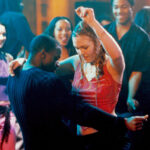Dance frequently enlivens fictional narratives, from spontaneous kitchen jigs to elaborate ballroom scenes and vibrant club nights. When writing these scenes, a common question arises: how should dance names be styled? Should they be capitalized, italicized, placed in quotation marks, or perhaps left in lowercase? The last option certainly feels incorrect for many dance names, highlighting a style question not often covered in standard style guides. However, through logical deduction and stylistic understanding, we can establish clear guidelines for writing Names For Dancing.
When referring to a specific dance with a set choreography, especially one linked to a particular song, treat its name as a proper noun. This means capitalizing it, similar to how you would capitalize place names or personal names. Crucially, do not use quotation marks or italics, as these are reserved for song or album titles, not dance names themselves. Think of dances like the Electric Slide or the Macarena; these are specific routines with established names.
For example:
We all joined in and danced the Electric Slide as soon as the music started.
At the wedding, everyone was up and doing the Macarena.
However, the approach differs for dance styles that can be performed to various pieces of music sharing a similar rhythm or beat. These are considered generic dance forms and should be treated as common nouns, meaning they are not capitalized unless they begin a sentence. Consider dances like the waltz, salsa, or tango. You can waltz to countless songs in three-quarter time, making “waltz” a general style rather than a singular, named dance.
For instance:
I’ve always wanted to learn salsa dancing; the energy looks incredible.
They moved across the floor in a graceful waltz.
This distinction mirrors stylistic decisions made in other areas of writing. Take the word “officemate.” While not in every dictionary, we can logically deduce its styling by looking at similar words like “roommate,” “bandmate,” and “teammate,” all of which are single words. Therefore, “officemate” as one word becomes a consistent and logical choice. Similarly, applying the rules for proper and common nouns offers a sound solution for styling names for dancing, even if style guides don’t explicitly address it. Consistency is key in maintaining clarity and professionalism in your writing.
By applying these guidelines, you can confidently and correctly style names for dancing in your writing, enhancing readability and ensuring stylistic accuracy.

